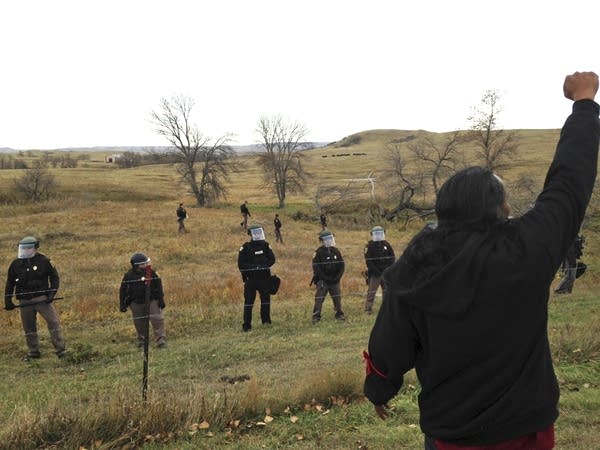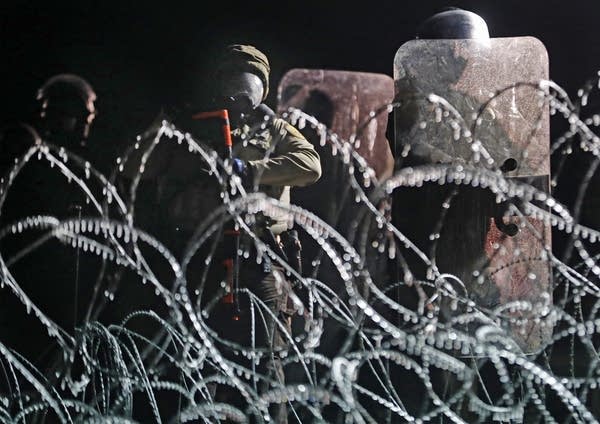Dakota Access pipeline cops push back on accusations of brutality

Go Deeper.
Create an account or log in to save stories.
Like this?
Thanks for liking this story! We have added it to a list of your favorite stories.
MPR News with Tom Weber devoted its Tuesday show to exploring the dispute in North Dakota over the proposed pipeline, with new reporting, updates and reflections from some of the key players in the story. This story was part of that reporting. | Full coverage
Despite the harsh winter, people opposed to the Dakota Access oil pipeline remain camped out on federal land along the Missouri River south of Bismarck.
Police have stopped manning a roadblock near the camp in what they said is an effort to de-escalate tensions.
But law enforcement authorities are still facing intense criticism, including a class-action lawsuit after a number of protesters were injured during confrontations.
Turn Up Your Support
MPR News helps you turn down the noise and build shared understanding. Turn up your support for this public resource and keep trusted journalism accessible to all.
For months, the Backwater Bridge has been the line of scrimmage between protesters and police. About three quarters of a mile north of the main protest camp, the small concrete span carries North Dakota Highway 1806 over a narrow creek. The highway is the shortest route to Bismarck, about 41 miles to the north, but it remains closed to all traffic.

Police have blocked the bridge with barbed wire and concrete barriers, and even though they've ended their round-the-clock presence, they're still threatening to arrest anyone who sets foot on it.
In late November, just before police left the bridge, they used a PA system to warn one protester.
"Sir, please move to the south off of the bridge to the south side of the bridge," an officer said. "The bridge is clearly marked that it is closed. Being there right now you are trespassing and subject to arrest."
Police did not arrest the man. He eventually ambled away. But the situation 10 days earlier, on Nov. 20, was much more tense.
With temperatures just below freezing, independent filmmaker Jake Westly Anderson of Utah had his camera rolling when police started dousing protesters with water from a fire hose mounted atop a vehicle. Several dozen people, many holding makeshift plywood and plastic shields, were about 15 feet from the roadblock when officers launched what appear to be tear gas canisters directly at them.
A number of protesters were hurt that night. In a class action lawsuit, nine self-described "water protectors" claim police projectiles caused injuries ranging from lacerations and bruising to broken knuckle bones.
Vanessa Dundon of Arizona, a member of the Navajo Nation and the lead plaintiff, said a tear gas canister struck her in the face, blinding her in the right eye.

"I have a less than 5 percent chance of seeing some form of light from this eye, but I'll never see again," Dundon said. "I don't know what I ever did to Morton County, because I've been here a very long time, and I've been on those front lines a very long time, and I have always been one to pull back my people from being agitators."
Sophia Wilansky, 21, who's not part of the class action, nearly lost her arm that night. She has undergone multiple surgeries to save it. At a news conference at Hennepin County Medical Center last month, Wayne Wilansky described his daughter's injuries.
"The force of the explosion blew the bone out of her arm," Wilansky said. "And all of the arteries and all of the muscle that supports her arm. It just blew out. It wasn't caused by a fire or anything else. This was a grenade. This was a weapon of war."
Wilansky said police threw the grenade; authorities strongly dispute that.

At a Dec. 3 news conference, Cass County Sheriff Paul Laney told reporters that Wilansky was likely hurt by improvised explosives that protesters set near a burned out truck on the road.
"There were explosive instruments being handled by people on that bridge that night," Laney said. "Whether their intent was to throw them at us or whether their intent was to blow up that truck, I don't know. But I do know that they were handling explosive devices and they handled it wrong and something happened."
Many protesters contend law enforcement is over-militarized. But Laney said a small segment of the movement is looking for a fight, and officers must defend themselves with helmets, shields and bulletproof vehicles.
Morton County Sheriff Kyle Kirchmeier said the ATF and North Dakota's Bureau of Criminal Investigation are looking into what caused Wilansky's injury.

Kirchmeier said nothing police used could have damaged the woman's arm so severely.
"There's tear gas, there's pepper spray," Kirchmeier said. "We don't have rubber bullets, there's sponge rounds, and then the beanbag rounds."
Kirchmeier said he's unaware of any use by police of non-lethal "flash-bang" or "stun" grenades.
Even though police and protesters who were at the Backwater Bridge Nov. 20 have widely divergent views about what happened, one outside observer who's experienced with street protests said law enforcement has been overly aggressive.

Norm Stamper was Seattle police chief in 1999, and he authorized the use of tear gas on demonstrators gathered there to protest World Trade Organization meetings. Stamper said he regrets that decision, and contends a combative response to peaceful protesting can escalate violence.
"Had we not used tear gas against passive resisting protesters, the vandalism, the violence that did in fact erupt might well have been avoided," Stamper said.
Police in North Dakota say they've shown restraint even in the face of violence. They're quick to point out that one protester, Red Fawn Fallis, 37, of Denver, is facing a federal firearms charge after a handgun she was allegedly carrying discharged as police arrested her during another incident at the Backwater Bridge in October.
Fallis, who's one of more than 570 people arrested since August, is being held in the Stutsman County Jail. The federal public defender's office said Fallis could face trial as soon as February.




